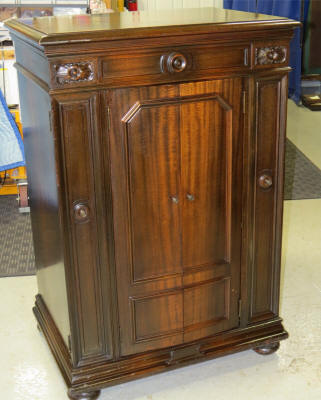
The Victor-Victrola Page

VE 8-60 X
RARITY: ¤¤¤ VALUE: ¤¤¤



The
VV 8-60 was a very unique model when introduced in the fall of 1926. It
shared the same cabinet and large Orthophonic horn as Victor's 'flagship'
Credenza model, but allowed the user to switch between acoustic reproduction and
electronic reproduction.
This model was introduced at a time when electronic
(tube amplified) phonographs were just starting to become affordable for home
use, but these early amplifiers were far from perfect. Although electronic
amplification could provide greater volume with more user control of listening
levels, it also could add hum and noise and other unwanted artifacts to the
music. The 8-60 allowed a direct comparison to be made between the two types of
reproduction, and it was possible to select the most pleasing method for a
particular recording or style of music.
Achieving both methods of playback required that the tonearm be equipped with 2
soundboxes; one acoustic and one electronic (picture at right). A mechanical
control valve allowed the user to switch the horn's input between the acoustic
output from the soundbox, or an from an electrical driver connected to the
amplifier (located at the bottom of the cabinet).
The original 1926 selling price of the 8-60 was a whopping $650.00, which
equates to over $9,500.00 in today's money. Like the Credenza, it featured
gold-plated hardware and an automatic brake to shut-down the turntable when a
record was finished.
A surprising total of nearly 3,500 VE 8-60 models were produced before it was
discontinued at the end of the year.
It is important to note how quickly this type of machine became obsolete due to
the incredibly rapid development of audio technology. Within a matter of months,
vastly superior amplifiers and paper-cone speakers became available at
affordable prices, quickly rendering machines such as the 8-60 to the status of
'dinosaurs' by the middle of 1927. While it likely sold well to wealthy buyers
when first introduced, it is probable that many of these machines were sold at a
significant discount throughout 1927.
The Borgia II model was the 'big brother' of the
8-60, as it shared the dual-playback capability for records, but added the
additional feature of an integrated radio.
While few have survived, the cost of restoration of
these early and complex models limits the interest of many collectors in today's
market. Rebuilding of the amplifier alone can cost well over $500.00.
.
The current survivor database shows the earliest existent VV 8-60 to be S/N 522 and the latest to be S/N 3546.
Do you own a Victrola 8-60? Please take a moment and enter some basic information about your machine into the collector's database by clicking here. No personal information is required.